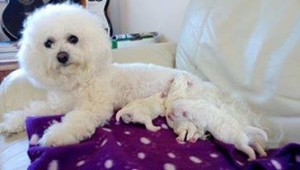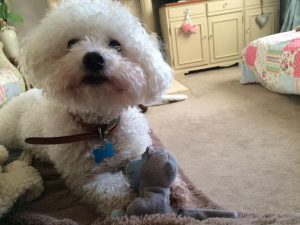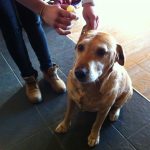The Bichon Frise.
The Bichon Frise or, “curly lap dogs”, were revered in the Royal palaces of Spain and France. Ever popular today, Holidays4Dogs takes a look at the fascinating history of the Bichon Frise.
These tough little dogs have a long ancestry going back to a breed known as the Barbet, or Water Spaniel. There were four types of Bichon which evolved from the Barbet and all originated in the Mediterranean area.
They were known as the bichon maltais, bichon bolognaise, bichon Havanese and bichon Tenerife. The latter variety later became known as the bichon frise we know and love today.
History.
These little dogs lived in Spanish and French palaces for centuries and doted on by Royalty. It was common to see bichon’s carried around in little baskets by the wives of French kings.
Bichon frise’s were often depicted in paintings during the 16th Century, some of which can be seen in the famous paintings by Goya.
By the end of the 19th Century, however, the bichon frise fell out of favour and went into decline.
A few dogs could be found among street entertainers, but they were generally regarded as street pests and companions of beggars.
As a result, the status of these little dogs plummeted from pampered pets of royalty to little more than scruffy little street dogs. Only the strongest of these dogs survived.
After the First World War, breeders in France, and also in Belgium, became interested in reviving the bichon. As a result, the bichon’s popularity rose again.
This little dog has most certainly had a colourful past which reflects, perhaps, the adaptable characters they retain today. Bichon frise’s are popular pets and much-loved companions the world over.
Character.
The Bichon Frise are small, but sturdy little dogs. Although they are lively and energetic, they don’t need vast amounts of exercise. Bichons generally get on well with other dogs, animals and people, since they are not naturally challenging, or aggressive. They are happy to accompany their owners to various new places and don’t normally become stressed in novel situations.
since they are not naturally challenging, or aggressive. They are happy to accompany their owners to various new places and don’t normally become stressed in novel situations.
They do, however, have a tendency to be ‘yappy’ and their bark can be quite piercing. Unfortunately, they are reputed to be notoriously difficult to house train.
As with all dogs, positive training approaches are essential as harshness can spoil these sensitive little dogs. However, equally, they do need to understand the house rules. Like many cute and endearing small dogs, it is easy for owners to become complacent about training.
Bichon’s need professional grooming every 4 to 6 weeks. This can be an expensive business, but you can learn to do this at home. They also need daily brushing to avoid the coat become matted.
Health.
Unfortunately, these little dogs are not free from hereditary disease and can suffer from a range of problems. These include skin allergies, eye problems, slipped knee caps, heart murmurs, Cushing’s disease, Addison’s disease and hereditary cataracts.
While there are currently no DNA tests available in relation to health issues within this breed, there are currently eye tests available for hereditary cataracts under the BVA and KC health schemes. Always purchase from breeders who have addressed this by eye testing their stock.
Conclusion.
The Bichon Frise is a particularly endearing small dog and are lovely pets for all types of families. Due to their calm temperament and small size, they make particularly good companions for older people. They do, however, still require as much care and attention as other breeds of dog.


